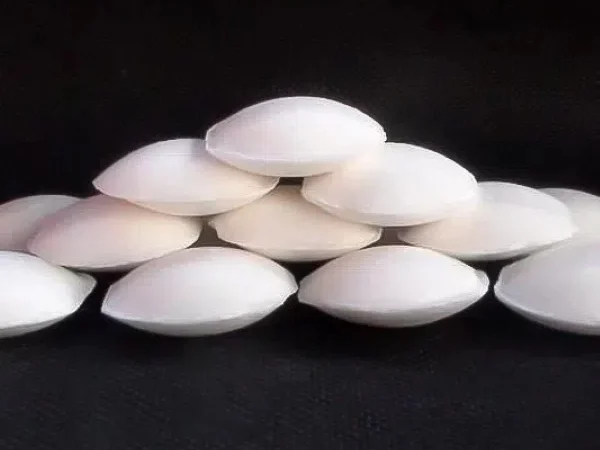
Sodium cyanide (NaCN) is a highly toxic inorganic compound with a wide range of applications across multiple industries. Despite its dangerous nature, its unique chemical properties make it an invaluable reagent in many industrial processes. This article explores the diverse fields in which Sodium cyanide is utilized.
Mining Industry
One of the most well - known applications of Sodium Cyanide is in the Mining industry, particularly for the extraction of precious metals. Gold and silver, which are often found in low - grade ores, can be effectively separated from the surrounding rock using a process called cyanidation. In the presence of oxygen and water, sodium cyanide reacts with gold or silver to form soluble metal - cyanide complexes. For example, the reaction with gold can be represented as:
4Au + 8NaCN + O₂+ 2H₂O → 4Na[Au(CN)₂]+ 4NaOH
This process allows for the efficient recovery of precious metals from large quantities of ore. Cyanidation is also used for the extraction of other metals such as copper, zinc, and platinum - group metals in some cases. However, due to the toxicity of cyanide, strict environmental and safety measures are in place to prevent the release of cyanide - containing effluents into the environment.
Electroplating and Surface Treatment
Sodium cyanide plays a crucial role in Electroplating processes. It is used as a major component in electroplating baths for depositing metals such as copper, silver, cadmium, and zinc onto various substrates. In the electroplating solution, cyanide ions act in several ways. They help to reduce the anode polarization, ensuring the smooth dissolution of the anode metal. This results in a more stable and consistent supply of metal ions in the solution. Additionally, cyanide ions increase the cathode polarization, which promotes the uniform deposition of the metal on the cathode surface, leading to a high - quality, evenly - coated finish. For example, in silver electroplating, the use of sodium cyanide in the plating bath helps to achieve a bright and adherent silver coating on objects like jewelry and electrical contacts.
Chemical Synthesis
1.Inorganic Chemical Production
Sodium cyanide serves as a key raw material for the synthesis of numerous inorganic cyanides. For instance, it is used to produce potassium cyanide (KCN), which is also widely used in various industries. By reacting sodium cyanide with potassium salts through metathesis reactions, potassium cyanide can be obtained. Other important inorganic Cyanides such as zinc cyanide (Zn(CN)₂), which is used in electroplating and as a catalyst in some chemical reactions, and copper(I) cyanide (CuCN), used in organic synthesis and electroplating, are also produced from sodium cyanide.
2.Organic Synthesis
In organic chemistry, sodium cyanide is a powerful nucleophile. It can participate in reactions such as nucleophilic substitution reactions with alkyl halides. This reaction, known as the Kolbe nitrile synthesis, is an important method for lengthening carbon chains. For example, when an alkyl halide (R - X) reacts with sodium cyanide, an alkyl nitrile (R - CN) is formed:
R - X+ NaCN → R - CN+ NaX
The resulting nitriles can be further transformed into other useful organic compounds. They can be hydrolyzed to form carboxylic acids or reduced to form amines, which are essential building blocks in the synthesis of pharmaceuticals, polymers, and other organic products.
Pharmaceutical Industry
Sodium cyanide is used in the synthesis of several pharmaceutical intermediates. For example, it is involved in the production of compounds like cyanacetic acid and its derivatives. Cyanacetic acid can be used to synthesize drugs such as barbiturates, which are used as sedatives and hypnotics. Another example is the synthesis of certain amino acids, which are fundamental components of proteins. Some amino acids are produced through synthetic routes that involve the use of sodium cyanide as a starting material or reagent in key reaction steps. These amino acids are then used in the formulation of dietary supplements and in the production of some medications.
Dye and Textile Industry
1.Dye Manufacture
In the dye industry, sodium cyanide is used in the production of certain dyes and dye intermediates. For example, it is involved in the synthesis of cyanuric chloride, which is an important intermediate for the production of reactive dyes. Reactive dyes are widely used in the textile industry due to their excellent colorfastness properties. Cyanuric chloride can react with various organic compounds to form a wide range of dye structures that can bind covalently to textile fibers, providing long - lasting coloration.
2.Textile Processing
In the textile industry, sodium cyanide can be used as a mordant in some dyeing processes. A mordant helps to improve the binding of the dye to the fabric, enhancing the color intensity and durability of the dyed material. Additionally, it is used in certain surface treatment processes for textiles, such as in the case of steel - based textile machinery parts where it may be involved in processes like liquid carburizing and nitriding to improve the hardness and wear - resistance of the metal components.
Pest Control and Fumigation
Due to its highly toxic nature, sodium cyanide has been used in pest control, particularly in the past for fumigation purposes. In enclosed spaces such as warehouses or storage facilities, cyanide - based fumigants containing sodium cyanide could be used to kill pests like insects, rodents, and certain fungi. However, the use of sodium cyanide in pest control has significantly decreased in recent years due to its extreme toxicity and the development of alternative, less hazardous pest control methods. Stringent safety regulations now govern its use in this area to prevent accidental exposure to humans and non - target organisms.
In conclusion, sodium cyanide, despite its toxicity, is an important chemical with a wide range of applications in industries such as mining, electroplating, chemical synthesis, pharmaceuticals, dye and textile, and pest control. However, its handling and use require strict compliance with safety and environmental regulations to minimize risks to human health and the environment.
- Random Content
- Hot content
- Hot review content
- Toxicity Assessment of Sodium Cyanide and Relevant Hazard Prevention Measures
- Powdery emulsion explosive
- Calcium Peroxide 60% Assay Yellowish Tablet
- Sodium Peroxide
- Antimonium Tartrate Potassium
- Sodium sulphate 99% Pharmacy Grade
- Pharmaceutical Intermediate Glycine with High Quality 99%
- 1Discounted Sodium Cyanide (CAS: 143-33-9) for Mining - High Quality & Competitive Pricing
- 2Sodium Cyanide 98% CAS 143-33-9 gold dressing agent Essential for Mining and Chemical Industries
- 3Sodium Cyanide 98%+ CAS 143-33-9
- 4Anhydrous Oxalic acid 99.6% Industrial Grade
- 5Soda Ash Dense / Light 99.2% Sodium Carbonate Washing Soda
- 6Oxalic acid for mining 99.6%
- 7Calcium hydroxide Industrial Grade 90%
- 1Sodium Cyanide 98% CAS 143-33-9 gold dressing agent Essential for Mining and Chemical Industries
- 2High Quality 99% Purity of Cyanuric chloride ISO 9001:2005 REACH Verified Producer
- 3 High-Quality Sodium Cyanide for Leaching
- 4Powdery emulsion explosive
- 5Industry Grade Electron grade 98% Sulfuric Acid H2SO4 Sulphuric Acid Battery Acid Industrial Sulfuric Acid
- 6Colloidal emulsion explosive
- 7sodium hydrosulfide 70% flakes used Mining Industry












Online message consultation
Add comment: